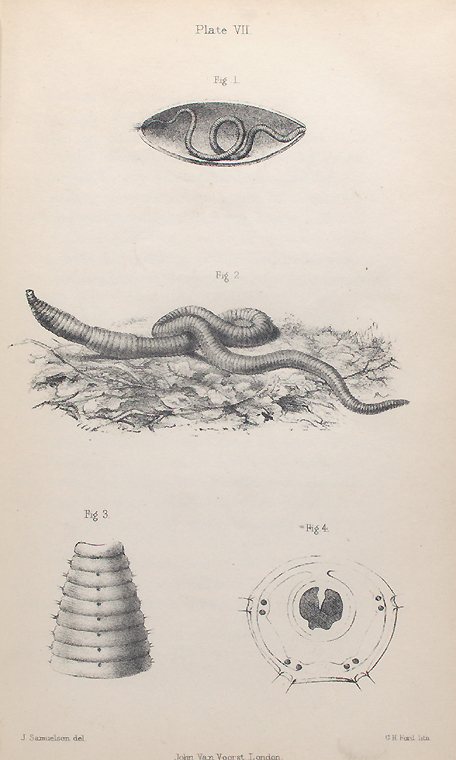Biblio File
The Importance of Earthworms: Darwin’s Last Manuscript

In his final book, The Formation of Vegetable Mould, Through the Action of Worms (1881) L. Sambourne's satiric portrait of Darwin published in Punch, 1881., Darwin concluded, "It may be doubted if there are any other animals which have played such an important part in the history of the world as these lowly organized creatures." If the concept of evolution didn’t give Darwin enough grief from his contemporaries, this monograph on worms provoked even more ridicule. But Darwin had the last laugh: The book was a runaway best-seller. Although its title would never fly with today's publishers, the book nevertheless sold more copies than his earlier books, due largely to England's healthy obsession with gardening.
L. Sambourne's satiric portrait of Darwin published in Punch, 1881., Darwin concluded, "It may be doubted if there are any other animals which have played such an important part in the history of the world as these lowly organized creatures." If the concept of evolution didn’t give Darwin enough grief from his contemporaries, this monograph on worms provoked even more ridicule. But Darwin had the last laugh: The book was a runaway best-seller. Although its title would never fly with today's publishers, the book nevertheless sold more copies than his earlier books, due largely to England's healthy obsession with gardening.
 The Tower of Babel? No, one of the more elegant illustrations of worm poop (or castings) published by DarwinWith the help of his children, with whom he set out early each morning (and often on rainy nights) while the ground was still cool and moist, Darwin observed and recorded the habits of the earthworm and its effect on soil formation. Darwin learned that worms literally move the earth in the process of their meanderings. Their passage through the earth aerates the soil and the natural chemistry of their guts renders soil and plant matter into fertile pellets. As a by-product of their movements, worms deposit new soil on the surface, causing whatever was on top to slowly submerge. Thus, whole monuments may be buried over a period of decades. It is estimated that for a single acre of cultivated land, earthworms move 8 tons of earth in a year, enough to produce a new layer of earth 2 inches thick, rich in nitrogen, phosphorous and calcium.
The Tower of Babel? No, one of the more elegant illustrations of worm poop (or castings) published by DarwinWith the help of his children, with whom he set out early each morning (and often on rainy nights) while the ground was still cool and moist, Darwin observed and recorded the habits of the earthworm and its effect on soil formation. Darwin learned that worms literally move the earth in the process of their meanderings. Their passage through the earth aerates the soil and the natural chemistry of their guts renders soil and plant matter into fertile pellets. As a by-product of their movements, worms deposit new soil on the surface, causing whatever was on top to slowly submerge. Thus, whole monuments may be buried over a period of decades. It is estimated that for a single acre of cultivated land, earthworms move 8 tons of earth in a year, enough to produce a new layer of earth 2 inches thick, rich in nitrogen, phosphorous and calcium.
Before the plough, the earthworm was the earth’s best tiller, as it digested earth and munched on leaves, leaving behind a rich humus layer. Vermiculture enthusiasts will agree that worm juice (or "compost tea") collected beneath their compost bins is a superior organic fertilizing agent for their gardens.
 Darwin's worm stone, with a central peg for measuring its submersion over timeOriginally a student of geology, Darwin was of course interested in how earthen strata transformed over geologic eras, but his uncle, Josiah Wedgwood, suggested he investigate a peculiar small-scale mystery: What made soil cover dissipate and disappear over time? Uncle Jos suspected the vanishing was achieved solely through the agency of the humble worm, and it soon became obvious that earthworms were indeed the culprit. Darwin measured the rate of burial by using his famous “worm stone” which was a stationary stone whose slow submersion was tracked and charted by Darwin and his son Horace.
Darwin's worm stone, with a central peg for measuring its submersion over timeOriginally a student of geology, Darwin was of course interested in how earthen strata transformed over geologic eras, but his uncle, Josiah Wedgwood, suggested he investigate a peculiar small-scale mystery: What made soil cover dissipate and disappear over time? Uncle Jos suspected the vanishing was achieved solely through the agency of the humble worm, and it soon became obvious that earthworms were indeed the culprit. Darwin measured the rate of burial by using his famous “worm stone” which was a stationary stone whose slow submersion was tracked and charted by Darwin and his son Horace.
NYPL has a digital version (also available to download) of an early edition of The Formation of Mould, a must-read for fans of gardening, a good example of the scientific method, and probably the most attractive pictures of worm poop you'll ever see. NYPL also has books about gardening and vermiculture (such as "Worms Eat our Garbage") for us compost-loving city folk.
Kids, parents and teachers, celebrate Earth Day by joining the Bug Bioblitz as part of the National Environment Education Week, April 15-21, 2012.
Read E-Books with SimplyE
 With your library card, it's easier than ever to choose from more than 300,000 e-books on SimplyE, The New York Public Library's free e-reader app. Gain access to digital resources for all ages, including e-books, audiobooks, databases, and more.
With your library card, it's easier than ever to choose from more than 300,000 e-books on SimplyE, The New York Public Library's free e-reader app. Gain access to digital resources for all ages, including e-books, audiobooks, databases, and more.
If you don’t have an NYPL library card, New York State residents can apply for a digital card online or through SimplyE (available on the App Store or Google Play).
Need more help? Read our guide to using SimplyE.

Comments
Darwin's Theory on Earth Worms
Submitted by Geraldine Nathan (not verified) on April 21, 2012 - 3:14pm
Partial Praise for Darwin
Submitted by Marcus Morgan (not verified) on May 12, 2013 - 6:52pm